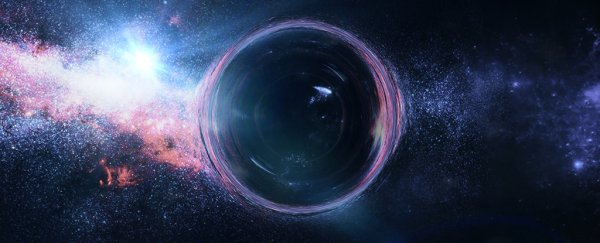After studying hundreds of recently discovered exploding stars, physicists have concluded it's unlikely there are sufficient numbers of primordial black holes out there to account for the dark matter phenomenon.
This doesn't mean the category of material referred to as massive compact halo objects (MACHOs) can't contribute to the unseen 84 percent of the Universe's mass. But it does mean we need to continue to look elsewhere for a full explanation.
University of California Berkeley researchers conducted a statistical analysis on the brightest type Ia supernovae discovered over the past four years, looking for any signs of distortion.
Supernovae have traditionally been used as galactic landmarks thanks to the assumption that we can work out their absolute luminosity from a few basic characteristics, providing a clear idea of their distance.
Theoretically, should there be hidden concentrations of mass between us and an exploding star, its light should warp or magnify in a way we can detect.
This kind of gravitational lensing has been used to amazing effect in recent years, allowing astronomers to peer even further into the Universe's outer reaches.
In this case, the researchers were looking for signs of a very particular kind of hidden mass dimpling space – primordial black holes. Specifically, compact black holes with masses larger than one tenth of our Sun's.
Black holes are things most of us are familiar with. Pack enough stuff into a small enough space, and at some point gravity will concentrate to the point that even light won't have the speed necessary to slip away.
Your average black hole tends to be the result of a heavy star collapsing in on itself after it loses the heat required to stay puffy; but primordial black holes are different. They're the result of an early growth spurt in the Universe.
Right after the Big Bang, trivial differences in concentration of energy quickly became big differences on a large scale, resulting in collapsed pockets of matter dotted throughout space.
For now they're theoretical. Nobody has empirical evidence they exist, so we can put them into the 'nice idea' box for the time being.
In 2016, following the second successful detection of gravitational waves picked up by the Laser Interferometer Gravitational Wave Observatory (LIGO), some researchers wondered if they'd found a sign of these ancient black holes.
The wave's signature pointed to objects that lined up with the primordial variety. Some astronomers suggested they could be responsible for the excess amounts of gravity holding together vast expanses of stars and dust.
"That was an interesting coincidence that got everyone excited," says UC Berkeley physicist Uroš Seljak.
But a coincidence is all it was, it seems.
The Berkeley physicists examined supernovae in two catalogues; 580 from the Supernova Cosmology Project's Union 2.1 collection, and 740 stars from the Joint Light-Curve Analysis.
Of all those stars, 8 should have been a touch brighter than expected if primordial black holes larger than 0.1 solar masses were behind dark matter's mysterious pull.
No such brightening was found when the data from all of the stars were pooled together, meaning if such objects truly did exist, that can't explain more than 40 percent of the dark matter story.
Of course there's no reason dark matter couldn't include a mix of unseen elements. But it would make models a lot more complicated.
"I can imagine it being two types of black holes, very heavy and very light ones, or black holes and new particle," says lead author Miguel Zumalacárregui from the Berkeley Center for Cosmological Physics.
"But in that case one of the components is orders of magnitude heavier than the other, and they need to be produced in comparable abundance."
Exactly how that would take place would be incredibly hard to explain, meaning the 'mixed model' theory isn't exactly an appealing proposition at this stage.
And a yet-unpublished study by the same team involving hundreds of more stars pushes the potential role for primordial black holes down even further, to less than 23 percent.
If you're a die-hard fan of the MACHO model of dark matter, then we can't say give up all hope - but the odds aren't in your favour.
This research was published in Physical Review Letters.
